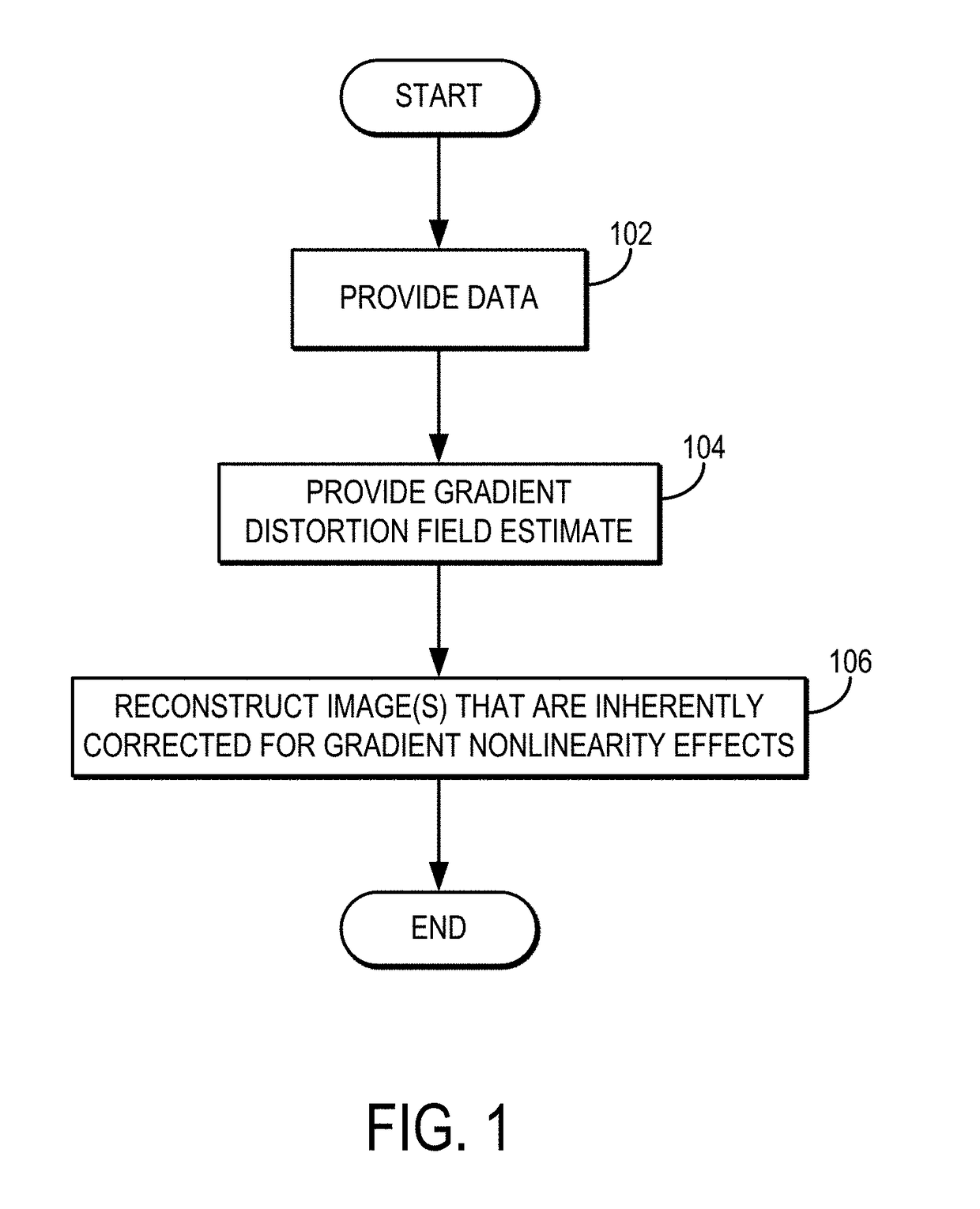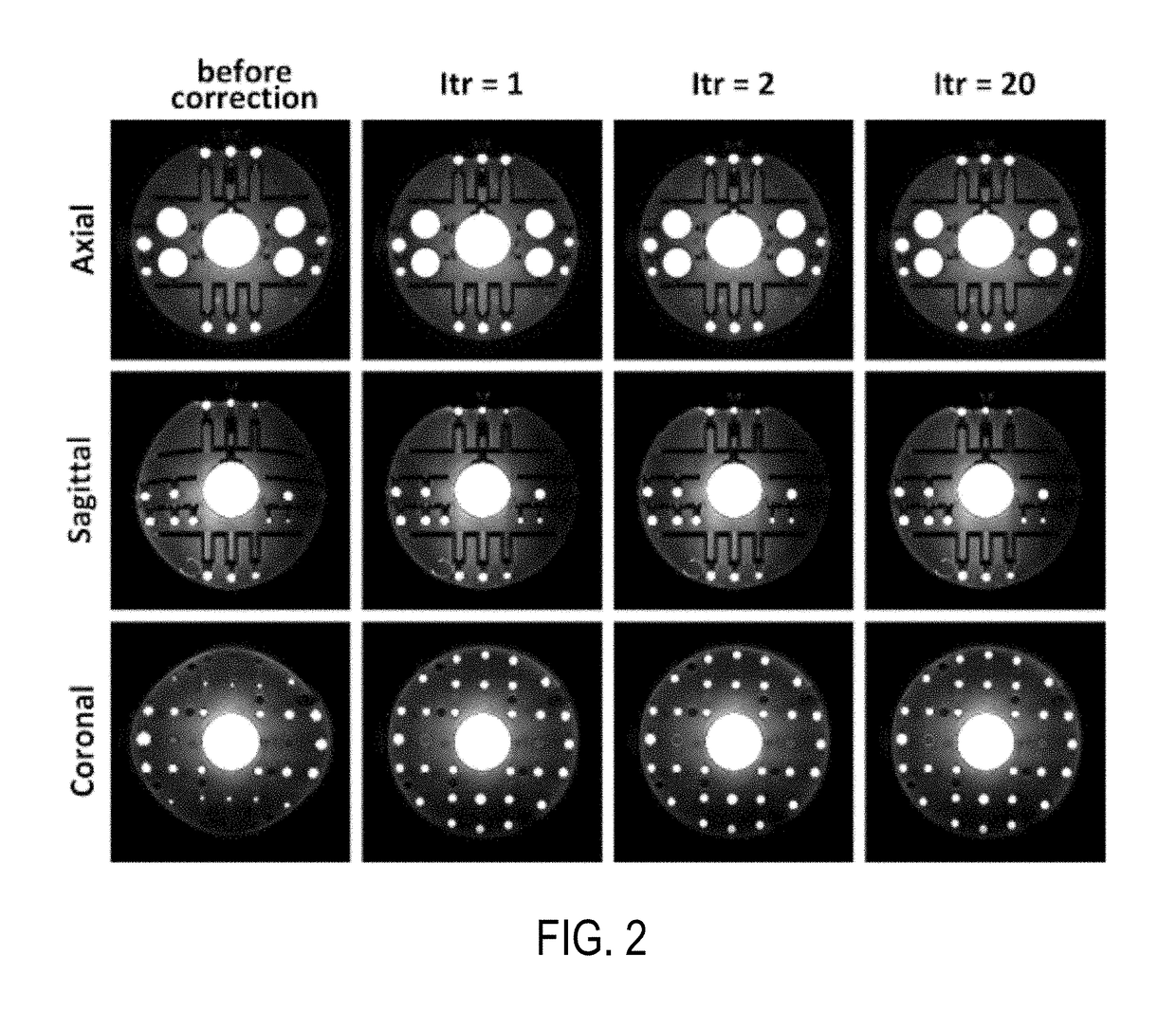Integrated image reconstruction and gradient non-linearity correction with spatial support constraints for magnetic resonance imaging
a magnetic resonance imaging and image reconstruction technology, applied in the field of integrated image reconstruction and gradient nonlinearity correction with spatial support constraints for magnetic resonance imaging, can solve the problems of degrading spatial resolution, not considering the approach, and never truly linear gradient fields used for spatial encoding in clinical magnetic resonance imaging (“mri”)
- Summary
- Abstract
- Description
- Claims
- Application Information
AI Technical Summary
Benefits of technology
Problems solved by technology
Method used
Image
Examples
example # 1
Example #1
Reconstruction for Fully Sampled Cartesian Acquisition
[0033]As one example, when Cartesian sampling is used with no undersampling (Φ=I) or regularization (λ=0), Eqn. (7) reduces to an ordinary least squares regression and has a simple closed form solution given by the following:
{U^}=argminU{AU-GF2}=(A*A)-1A*G;(8)
[0034]which can be iteratively solved via standard or conjugate gradient descent. The inverse Gramian matrix, (A*A)− can be well approximated by a diagonal matrix constructed from the Jacobian determinant of the distortion field, J, which in turn provides a noniterative pathway for performing coil-by-coil gradient nonlinearity corrected reconstruction of fully sampled Cartesian MRI data, as follows:
{Û}={Ûapprox}=JA*G (9).
[0035]The approximate solver in Eqn. (9) is a noniterative method based on the signal model described above, and thus utilizes explicit oversampled interpolation and deapodization steps, which enables the later performance of coarse geometric dis...
example # 2
Example #2
Partial Fourier Homodyne Acquisition
[0036]As another example, gradient nonlinearity can be corrected for during reconstruction of data acquired using a partial Fourier homodyne acquisition. Partial Fourier accelerations are based on the assumption that the target signal is strictly real-valued, and that any spurious image phase is either a priori known or can be easily estimated from a low-frequency reference signal. Because the Fourier transform of a real-valued signal is conjugate symmetric, partial Fourier methods enable upwards of two-fold acceleration.
[0037]Assuming that the target signal is real-valued, the signal model in Eqn. (4) can be re-expressed as:
g=Aψur+n (10);
where the notation ur denotes that the target signal is real-valued. The diagonal matrix, ψ (where ψi,i=ejθi) represents the apparent image phase that may be due to receive B1 field inhomogeneity, off-resonance, eddy current effects, or combinations thereof. As described below, this apparent image pha...
example # 3
Example #3
GRAPPA
[0045]In general, the integrated gradient nonlinearity and image reconstruction technique can be adapted for accelerated acquisitions, such as those implemented for parallel imaging techniques. In general, parallel imaging techniques exploit redundancies between data acquired using phased array receivers to reduce the amount of data required to generate an MR image.
[0046]As one example, the integrated gradient nonlinearity and image reconstruction technique can be adapted for GRAPPA-based acquisitions and reconstructions. GRAPPA is an auto-calibrating k-space based parallel imaging method that reconstructs a full set of coil images from undersampled k-space data.
[0047]Denoting G as the M×C multi-channel k-space data matrix, where M and C are the number of k-space measurements per coil and the number of coils, respectively, the forward signal model of GRAPPA is,
G=AU+N (17);
[0048]where U is the N×C matrix (where N denotes the total number of image pixels) representin...
PUM
 Login to View More
Login to View More Abstract
Description
Claims
Application Information
 Login to View More
Login to View More - R&D
- Intellectual Property
- Life Sciences
- Materials
- Tech Scout
- Unparalleled Data Quality
- Higher Quality Content
- 60% Fewer Hallucinations
Browse by: Latest US Patents, China's latest patents, Technical Efficacy Thesaurus, Application Domain, Technology Topic, Popular Technical Reports.
© 2025 PatSnap. All rights reserved.Legal|Privacy policy|Modern Slavery Act Transparency Statement|Sitemap|About US| Contact US: help@patsnap.com



